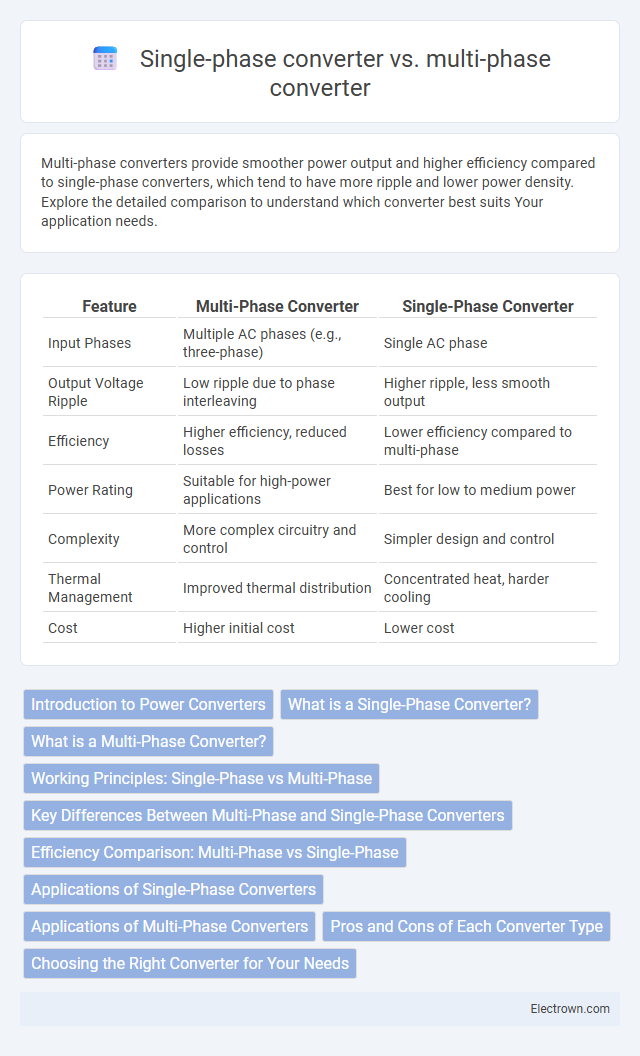Multi-phase converters provide smoother power output and higher efficiency compared to single-phase converters, which tend to have more ripple and lower power density. Explore the detailed comparison to understand which converter best suits Your application needs.
Table of Comparison
| Feature | Multi-Phase Converter | Single-Phase Converter |
|---|---|---|
| Input Phases | Multiple AC phases (e.g., three-phase) | Single AC phase |
| Output Voltage Ripple | Low ripple due to phase interleaving | Higher ripple, less smooth output |
| Efficiency | Higher efficiency, reduced losses | Lower efficiency compared to multi-phase |
| Power Rating | Suitable for high-power applications | Best for low to medium power |
| Complexity | More complex circuitry and control | Simpler design and control |
| Thermal Management | Improved thermal distribution | Concentrated heat, harder cooling |
| Cost | Higher initial cost | Lower cost |
Introduction to Power Converters
Multi-phase converters provide higher efficiency and reduced ripple compared to single-phase converters, making them ideal for applications requiring stable and clean power output. Single-phase converters typically handle lower power loads and have simpler designs but may suffer from higher harmonic distortion. The choice between multi-phase and single-phase converters depends on the power quality requirements and system complexity in power conversion applications.
What is a Single-Phase Converter?
A single-phase converter converts AC power from a single-phase supply into DC power, commonly used in low-power applications such as small motors and residential electrical devices. It typically includes components like diodes or thyristors to rectify the AC input and may provide limited power quality and efficiency compared to multi-phase systems. Single-phase converters are simpler and less expensive but often produce higher ripple and lower output smoothness than multi-phase converters.
What is a Multi-Phase Converter?
A multi-phase converter is an advanced power electronics device designed to convert electrical energy between different voltage and current phases, improving efficiency and reducing ripple in power delivery compared to single-phase converters. It utilizes multiple input or output phases, typically three or more, to distribute load more evenly and enhance thermal performance in applications like motor drives and renewable energy systems. This technology is essential for high-power, high-reliability environments requiring smoother and more stable electrical output.
Working Principles: Single-Phase vs Multi-Phase
Single-phase converters operate by converting AC power from a single alternating current source into DC, using components like diodes or thyristors to rectify the waveform in a single-phase cycle; this results in higher ripple and lower efficiency. Multi-phase converters utilize multiple AC sources or phases simultaneously, each shifted in time, to produce smoother DC output with reduced ripple and improved power factor due to the overlapping phase currents. The multi-phase approach enhances overall system reliability, efficiency, and performance in power conversion applications compared to single-phase systems.
Key Differences Between Multi-Phase and Single-Phase Converters
Multi-phase converters distribute power across multiple phases, resulting in smoother output voltage, reduced ripple, and higher efficiency compared to single-phase converters. Single-phase converters typically handle lower power levels and can cause more significant voltage fluctuations, making them less suitable for high-performance applications. Understanding these differences helps you select the right converter for stability, efficiency, and load requirements.
Efficiency Comparison: Multi-Phase vs Single-Phase
Multi-phase converters deliver higher efficiency than single-phase converters due to reduced ripple current and improved thermal distribution, which minimize power losses and enhance performance. Your application benefits from a smoother output voltage and better load regulation in multi-phase designs, especially under high current conditions. Single-phase converters, while simpler and cost-effective, typically exhibit lower efficiency and increased stress on components, leading to greater heat dissipation and reduced lifespan.
Applications of Single-Phase Converters
Single-phase converters are predominantly used in residential and light commercial applications where power requirements are relatively low, such as in household appliances, lighting systems, and small motor drives. Their simple design and lower cost make them suitable for single-phase power supply systems commonly found in urban and suburban areas. Single-phase converters efficiently handle power conversion in circuits with steady load conditions and moderate power consumption.
Applications of Multi-Phase Converters
Multi-phase converters are widely used in high-power applications such as electric vehicles, industrial motor drives, and renewable energy systems due to their ability to deliver higher efficiency and reduced ripple current compared to single-phase converters. These converters provide better thermal distribution and improved electromagnetic compatibility, making them ideal for powering multi-phase motors and complex electronic loads. Your choice of a multi-phase converter ensures enhanced performance and reliability in demanding industrial and commercial environments.
Pros and Cons of Each Converter Type
Multi-phase converters offer higher efficiency and smoother power delivery by distributing electrical load across multiple phases, reducing harmonic distortion and improving reliability, but they tend to be more complex and costly to install and maintain compared to single-phase converters. Single-phase converters are simpler, less expensive, and easier to maintain, making them suitable for smaller applications with lower power demands, though they can suffer from increased ripple, reduced efficiency, and greater stress on electrical components. Your choice depends on the power requirements, budget, and desired reliability for the specific application.
Choosing the Right Converter for Your Needs
Multi-phase converters offer higher efficiency, reduced ripple current, and improved thermal performance compared to single-phase converters, making them ideal for applications requiring stable and reliable power delivery. Single-phase converters are simpler and more cost-effective for low to moderate power applications but may struggle with efficiency and noise in high-demand scenarios. Evaluating your power requirements, space constraints, and budget will help you choose the right converter to optimize your system's performance.
multi-phase converter vs single-phase converter Infographic

 electrown.com
electrown.com